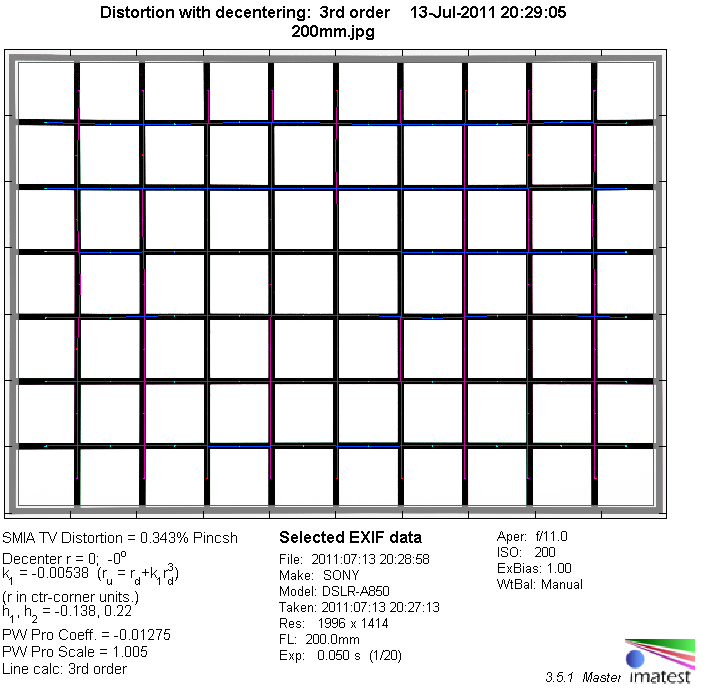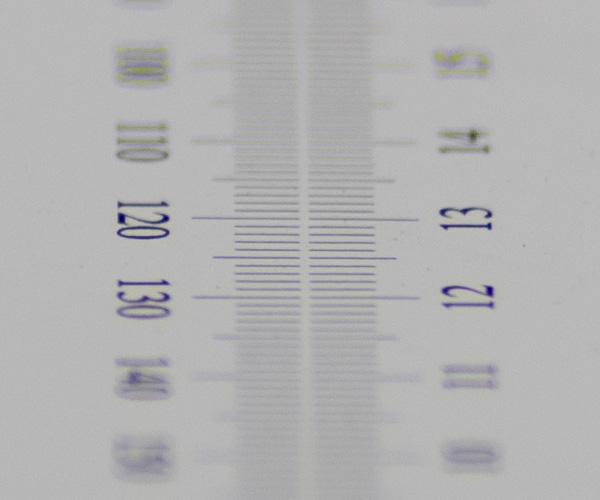|
Minolta AF 200mm f/2.8 APO G HS - Review / Lab Test - Analysis |
|
Lens Reviews -
Sony Alpha (Full Format)
|
|
Page 2 of 2

Distortion
The distortion characteristic is no suprise - it produces a marginal degree of pincushion distortion which is not relevant from a user perspective.

Vignetting
The light-falloff is comparatively moderate albeit clearly visible with of a drop of ~1.2EV (f-stops) at f/2.8. The issue is negligible from f/4 onwards.

MTF (resolution)
The most interesting aspect is, of course, its resolution potential and the lens is indeed capable of delivering excellent if not outstanding results. It is already very good to excellent at f/2.8 and that's across the full format frame. The image center reaches breathtaking levels at f/4 and f/5.6 whereas the borders/corners only improve marginally (on this very high level). Diffraction effect decrease the quality from f/8 onwards but the lens remains perfectly usable at f/11. The field curvature is minimal. The centering quality of the tested sample was good.
Please note that the MTF results are not directly comparable across the different systems!
Below is a simplified summary of the formal findings. The chart shows line widths per picture height (LW/PH) which can be taken as a measure for sharpness.
If you want to know more about the MTF50 figures you may check out the corresponding Imatest Explanations
Chromatic Aberrations (CAs)
Lateral CAs (color shadows at hard contrast transitions) are very well controlled with an average CA pixel width of less than 0.8px at the image borders - the positive effects of the APO design shows up here. This is rarely visible in prints.

Bokeh
Users are also raving about the quality of the bokeh - the out-of-focus blur. Based on our finding it is certainly very good but it shows a slight weakness regarding the rendering of out-of-focus highlights. They show a slight outlining effect at f/2.8 the the shaped deteriorates to an edgy (aperture-)shape at f/4 already. There's also the usual "cat's eye" shape (caused by vignetting) towards the image corners at large apertures but that's a common effect.
 The quality of the background- and foreground blur is very smooth and buttery.
The quality of the background- and foreground blur is very smooth and buttery.

Longitudinal (Axial) Chromatic Aberrations (LoCA)
Large aperture lenses suffer from bokeh fringing which related to the purple (front) to purple (back) focus halos around the focus point. The Minolta is no exception to the rule here (so it is not a "super-apochromat"). The fringing is clearly visible at f/2.8 (in certain situations) but it's already much reduced at f/4 and not a real issue anymore from f/5.6 onwards.
|
Move the mouse cursor over the f-stop marks below to observe the respective LoCAs
|
| f/2.8 |
f/4 |
f/5.6 |
f/8 |
|

|
Verdict
The Minolta AF 200mm f/2.8 APO G HS is a marvel of a lens indeed. It is sharp as a tack in the relevant aperture range and even superior to the current Sony 70-200mm f/2.8 APO G SSM. There's a visible amount of vignetting at f/2.8 but this is gone once you stop down a little bit. Distortions are not a relevant issue and neither are lateral CAs. The quality of bokeh is generally very good with only a minor weakness with respect to the highlight rendition. Bokeh fringing can be a problem at f/2.8 in certain situation but that's rather typical for a lens in this class.
Just like most of its G-class cousins, the build quality of the lens is on a professional level. Besides a metal body design it features a couple of goodies such as a retractable build-in lens hood (I always like this one), a focus limiter/hold, a slide-up cowling for the focus ring and it's compatible to the Sony/Minolta APO converters. The AF is certainly very fast albeit noisy due to the rather dated AF drive-screw mechanism.
So is it still worth it ? Well, definitely - highly recommended! And Sony .. please bring it back to us. It's really an easy win for you as well as your customers!
|